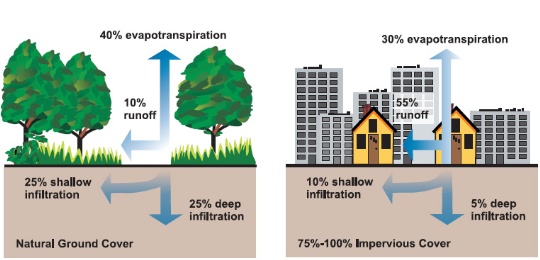Stormwater Management
All stormwater runoff that does not seep into the ground or evaporate finds its way into the City's stormwater system. In the City of Hahira, the stormwater system is separate from the sanitary sewer system so when it rains, oil, antifreeze, pesticides, and other pollutants are washed from driveways, yards, parking lots, and streets into the stormwater system and released into our local watershed with no treatment. As a result, it is important to implement Stormwater Management practices to help reduce and/or ellimate pollution from entering our community waterways and impacting our watersheds.
You can find our Stormwater Management Program (SWMP) HERE
Watersheds
A watershed is the land that drains into a body of water such as a stream, lake or wetland. Because water flows downhill, watershed boundaries are always located on the top of hills or mountains. Rain falling on one side of the hill will flow into one watershed, while rain falling on the other side of the hill will flow into another watershed. Any changes to the land in a watershed will affect the water body it drains into, such as a stream or pond.

As we develop land, creating more impervious surfaces such as roof tops, sidewalks and streets, rain water has less area to soak into the soil. Instead, it flows over streets and sidewalks then into stormwater systems that empty into our waterways, sometimes at high velocities which can cause erosion. Rainwater can also pick up pollutants such as sediment from construction sites, contaminants from streets, and fertilizers or pesticides from lawns. These types of pollutants are often called non-point source pollution and is one of the major threats to waterways today. Because non-point source pollution is not associated with a specific point of entry into a water body, it is more difficult to regulate than point source pollution, pollution from a designated source.
Stormwater Ordinances and Manual
- Illicit Discharge and Illegal Connection (2014)
- Soil Erosion, Sedimentation, and Pollution Control (2015) and Amendment (2017)
- Stormwater Management (2007)
- Georgia Stormwater Management Manual Volumes 1 & 2 (2016)
Best Management Practices (BMPs)
The Georgia Environmental Protection Division (EPD) defines a best management practice (BMP) as both structural devices to store or treat stormwater runoff and non-structural programs or practices which are designed to prevent or reduce the pollution of the waters of the State of Georgia. Structural BMPs can be thought of as engineering solutions to stormwater management. Structural BMPs are used to treat stormwater at the point of generation or the point of discharge. They can serve many different functions based on their design. Some structural BMPs are designed particularly for urban areas, whereas others may be designed for agriculture or forestry. Non-structural BMPs are just that, non-structural. There are no physical structures associated with these types of BMPs. They are designed to limit the amount of pollutants available in the environment that would potentially end up in stormwater runoff. Non-structural BMPs typically lessen the need for the more costly structural BMPs. This can be achieved through education, management and development practices. Here are a few BMP examples:
| Structural BMPS | Non-Structural BMPs |
| Rain Barrel | Picking up after your pet |
| Buffer Strips and Swales | Washing your car on grass |
| Native Plants | Getting a soil test |
| Constructed Wetlands | Disposing yard debris properly |
| Pervious Pavement | Disposing paint and chemicals properly |
Educational Resources
- After the Storm Pamphlet
- Automotive Repair and Maintenance Stormwater Tips
- Commercial Car Wash Stormwater Tips
- Construction Industry Stormwater Tips
- Earth 911
- Every Drop Counts Brochure
- Every Drop Counts Card
- Food/Restaurant Industry Stormwater Tips
- Gas Stations/Convenience Stores Stormwater Tips
- Georgia Department of Natural Resources Environmental Protection Division (EPD)
- Georgia Soil & Water Conservation Commission
- Lawn Care Service Providers Stormwater Tips
- Mobile Car/Power Wash Stormwater Tips
- Residential Oil and Grease Tips
- Painting Stormwater Tips
- Pool Maintenance Stormwater Tips
- Home/Charity Car Wash Stormwater Tips
- Residential Stormwater Tips
- Transportation Industry Stormwater Tips
Additional Resources
For more information, please contact the Public Works Department at 229-794-2330 or send an e-mail to This email address is being protected from spambots. You need JavaScript enabled to view it..
